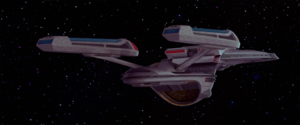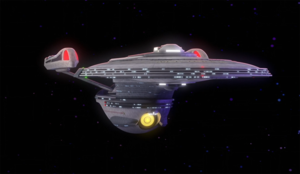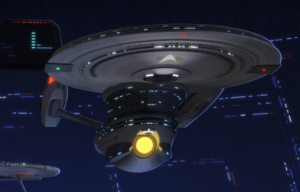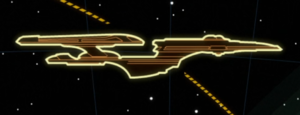Obena Class
More actions
The Obena-class emissary was developed in the years following the Dominion War to champion Federation diplomatic interests as a dedicated first contact and humanitarian relief vessel. Initially intended to replace the Excelsior on a one-for-one basis as a from-scratch new design, the hull was consciously designed with similar lines to her classic predecessor, making the sight of her stir the memory of Starfleet’s golden years. But above all she is a vessel intended to be seen: to travel Federation borders and visit Federation neighbours, and do the necessary work to rebuild a war-torn galaxy and its relationships. Ultimately, the destruction of Utopia Planitia Fleet Yards in 2385 led to the Obena project being put on hold, in favor of converting existing Excelsior-class vessels into combat-ready Excelsior II-class heavy cruisers. In the intervening time, they have also become popular as engineering support vessels, as their large holds and powerful engines can be used for large-scale construction projects just as well as humanitarian projects. Limited production of Obena-class starships resumed in 2399 when Starfleet resumed a more balanced starship construction program.
Exploration and Science
As with other Starfleet cruiser types, the Obena has a large and well-equipped science department, with multiple labs across Starfleet's core scientific disciplines and mission-configurable space for visiting scientists to use to conduct secondary and tertiary missions. While fully capable of general exploratory missions, the Obena's purpose is narrower: she is first and foremost mean to seek out new civilizations and make contact. Thus, her scientific load-out is tuned to cultural observation and analysis. Often, an Obena would be sent to a world known to have a warp-capable species that has already been discovered by a scout or front-line explorer. Their large cargo holds and industrial replication facilities would allow them to hold enough supplies for extended-range missions without support, which may become a more regular operational mode for this class once more of them are built and they are less in demand for humanitarian missions.
As diplomatic vessels, Obena-class vessels are uniquely positioned to cultivate the exchange of scientific information between cultures. As such, they have a specialized laboratory facility that is equipped to handle the data and power standards of dozens of different races' equipment and to adapt to new technologies. This lab can be used not only to reverse engineer alien technology but to allow visitors to share information with direct computer access.
Diplomacy
The Obena is one of the foremost diplomatic platforms of Starfleet, surpassed only by the likes of the Odyssey, hence its designation as an emissary. Designed to ape the appearance of the Excelsior, it was Starfleet’s hope that the mere sight of an Obena would remind friends and enemies of the height of Federation power and generosity alike. While she is more than capable of defending herself in a fraught warzone, the intention of her design is to send the message that the Federation has come to talk, not to implicitly threaten. If an Obena arrives to a negotiation, it is a sign Starfleet is taking the matter seriously, and that it expects - or wants - the eyes of the galaxy upon it.
An Obena boasts extensive guest and VIP quarters and conference spaces, and can usually make office space available for diplomatic staff aboard. These facilities are located close to the ship’s amenities to allow guests and delegates to spend their time aboard in comfort. While well suited to first contact missiosn, an Obena is also an excellent choice for hosting negotiations or ferrying delegates among powers who understand the prestige of what she symbolises. An Obena's vast cargo holds and industrial replicators are intended to be used for humanitarian relief missions, but they also allow an Obena to deploy communications equipment and other infrastructure during a first contact that often has to wait until a second contact mission.
Engineering
While sharing a design lineage with the Excelsior and Excelsior II, the Obena was developed from the ground up as an entirely separate class. Many of the systems incorporated into the Obena are ultimately derived from the Sovereign, with modifications to emphasize long-term reliability over pure performance. Wherever possible, the designers of the Obena made efforts to maximize the ship's internal habitable volume through the miniaturization of equipment and by relocating larger components into external structures. This is particularly true of the propulsion systems: the warp core arrangement ultimately derives from the California, with a shorter, multi-stage reaction chamber housed in a large dome directly between the warp nacelles in order to save space within the hull. The warp core and antimatter pods can be ejected through a large hatch on the top of the dome. The nacelles themselves are similar to those of the Sovereign, but shorter and wider—they two fewer rows of warp coils, but the remaining coils were increased in size.

Obena-class vessels are capable of separating and reattaching their saucer sections without starbase support. This functionality is rarely used, as the saucer is not warp capable, but it is intended to allow either half of the ship to serve as a self-contained lifeboat in an emergency.
Though the original intent behind the design was for a ship that could deliver humanitarian supplies as part of diplomatic duties, the Obena is an excellent ship for purely engineering missions as well. There is a single shuttle bay on the stern, which is capable of handling a dozen shuttles and a handful of runabouts, comparable to other cruiser designs. Cargo facilities are extensive, with multiple holds having direct access to space in the undercut of the stern. The class has a dedicated industrial replicator complex which can be used to create prefabricated buildings, ground vehicles, and other equipment necessary for humanitarian missions. They often embark Starfleet Corps of Engineers teams to provide priority response capabilities for engineering missions, as well as to assist in first contact missions, making them capable of performing the same roles as smaller utility cruisers but with greater speed and tactical capabilities.
Tactical

As the design brief for the Obena called for a primarily diplomatic mission profile, the class is more lightly armed than other large cruisers. Though few in number, the ship's six phaser arrays provide coverage of all firing arcs other than the area directly beneath the ship's stern. The forward torpedo launchers are housed in a dome just forward of the main deflector dish, which helps preserve space within the main hull for other systems. The two aft launchers are located in the undercut of the stern. Because of the geometry of the hull and the location of these launchers, Obena-class starships can't target threat vessels with torpedoes from beneath. In general, the weapons coverage on the Obena is best-suited to keeping engagements at long range. Where armaments have been sacrificed, shield systems have been comparatively strengthened, and so the Obena has the strongest model of regenerative shields put into service before the newer metaphasic standard. These features make the Obena primarily a defensive combatant; when the decision is made to stand and fight, a ship of this class can hold out for reinforcements.
With her somewhat unusual impulse engine layout, Obena-class starships are surprisingly maneuverable for their size, able to quickly roll to bring their fewer, but still powerful, weapons to bear on a target. Their handling characteristics more closely resemble frigates or escorts than cruisers when full power is applied, a feature that captains must learn to wield wisely through experience with this unique vessel's capabilities. As diplomatic ships, Obena-class vessels are not a good choice for purely tactical missions, but they can confidently transport dignitaries and ambassadors into area where combat is possible, thanks to their solid defenses. In turn, their lack of extensive armaments make the Obena more trustworthy as an emissary.
Shipboard Life

Obena-class starships are popular assignments, particularly highly-sought by officers interested in diplomatic operations or working to the immediate good of Federation territories. Because of the highly-symbolic nature of these ships, their crews are carefully-selected and commanding officers are usually experienced captains trusted to make serious decisions with possibly high-profile ramifications.
Accommodation standards are high, with most officers enjoying solitary quarters and all but the most junior aboard given at least their own room with a shared living space. Crewmen rarely share quarters with more than one other. On-board facilities are luxurious and comfortable, with multiple crew messes and a private lounge for the senior staff and guests. There are several facilities such as ballrooms and a theater that are intended to allow the Obena to put on a show for guests, but which can also be used for crew recreation. Further entertainment is provided by multiple holodecks.
Medical facilities are state-of-the-art to reflect the Obena’s use in humanitarian missions, and include holographically-configurable space that can operate as a pop-up shelter for disaster relief, or otherwise be reserved for cargo or mundane operations.
Class History

The decade between the Borg attack of 2366 and the end of the Dominion War was an era of unprecedented militarisation for Starfleet reflected in their starship design. Even the development of the new flagship was impacted, with the Sovereign-class the most tactically capable starship ever built by the Federation. The end of the war left many corners of the Alpha and Beta Quadrants devastated, with diplomatic relationships altered or strained and worlds and governments in desperate need of rebuilding. Starfleet was eager to meet these challenges and return to its primary mandate of exploration and diplomacy, and needed new ships to perform these missions.
The earliest designs for the Obena had been proposed in the development of the Sovereign, but dismissed as militarisation demanded a more tactical profile. Now R&D returned to these designs, the modernisation of the Excelsior-class considered a more positive design choice by a Starfleet keen to evoke halcyon days of peace. The Obena could be more quickly and easily built than the massive Galaxy-class, with a reduced tactical profile than the Sovereign allowing greater scientific and diplomatic facilities, without the exclusive focus on deep-space operations far from Federation territory of the Luna-class.
The similarities to the Excelsior were mostly cosmetic, the Obena required to be a larger ship to impress friends and enemies alike, and fulfill missions of exploration and humanitarian aid. Plans drew on lessons in ship design that Starfleet had mastered in its rapid development of the previous decade to enable a relatively swift development period. The Obena was not intended to push the envelope, but rather be equipped with the best technology already implemented and perfected.
The project was greenlit in early 2376, and the work already done on the initial proposal and the use of refined and reliable technology allowed rapid progress. The USS Obena was launched from Utopia Planitia in mid-2379 to conduct a shakedown cruise, and was commissioned in early 2380. Construction on more ships began at once, with Obenas going on to play a key role in Federation diplomacy and humanitarian operations of the early 2380s. While capable of performing deep-space exploration, Starfleet was loath to send its newest figurehead far from borders, and Obena captains reported mixed experiences. Some visited neighbouring powers to rebuild key relationships and help those in the galaxy most in need, while others spent long months on cruises they described more as morale-boosting exercises than truly essential. To emphasize their diplomatic and humanitarian capabilities and distinguish them from other cruiser designs, the Obena-class was officially designated as an emissary-type vessel, a type that would also be applied retroactively to the Ambassador class as well.
Word of the Romulan Supernova and Starfleet’s rush to aid evacuation gave the Obenas a significant role in the initial response; they were big ships capable of venturing into sometimes volatile regions and lending support to stricken and troubled worlds. While this ended with the Attack on Mars and the Federation’s withdrawal of support for the Romulan Star Empire, these years largely carved out the Obena’s role for the next decade.
With morale shattered across the Federation, Starfleet turned inward, conducting fewer missions of exploration. The Obena's role in shoring up the Federation's diplomatic situation became more vital, through maintaining vital peace treaties with neighbours large and small, and maintaining stability in fringes of the Federation no longer receiving the same level of support to which they had grown accustomed. In some cases, the arrival of an Obena meant an influx of supplies and supportive infrastructure. In others, Starfleet seemed to think that sending a ship that looked like the golden days was enough, and to particularly embittered citizens of Federation border worlds, the Obena has become known as ‘the empty promise.’
Following the destruction of Utopia Planitia Fleet Yards, Starfleet quietly terminated the Obena-class program, as there was an immediate shift to building combat-ready classes as the Federation turned inward. It was judged that it was a better use of resources to begin updating and retrofitting existing Excelsior-class vessels, including those that had already been mothballed, to create a modernized heavy cruiser to shore up the middle echelon of Starfleet's assets. The simplified, more tactically-oriented Excelsior II was the result of this decision, and all of the resources assigned to the Obena were instead spent rebuilding the Excelsior fleet. Thus, the class that was intended to replace the Excelsior was instead supplanted by a redux of the original Excelsior line.
The Obena-class ships already in service remained in high demand for diplomatic missions, but as first contact opportunities dried up, a signifcant number of them were placed under the auspices of the Starfleet Corps of Engineers. Their holds, originally intended for humanitarian supply missions, were just as useful for large-scale engineering projects. As they were faster and better armed than either the Parliament or the California, they were ideal for urgent projects, especially disaster relief missions. Indeed, the Starfleet Corps of Engineers lobbied on several occasions for Obena production to resume as a fully engineering-oriented vessel, but this proposal wasn't taken up.
In 2399, the Romulan subterfuge leading to the Federation's isolationism was revealed, and Starfleet began a program to expand back into the galaxy. Though the Obena was an older design by this point, production was diverted in several yards from Sovereign-class exploratory cruisers to Obena-class emissaries, as they use similar components and yard facilities. It is envisioned that Obena-class vessels will be built for the foreseeable future until another mid-sized diplomatic vessel design using the most modern equipment is devised.
In Play
- An Obena and an Excelsior II are both mid-sized starships that resemble the Excelsior, but they are actually quite different: an Obena was a fully new design that incorporates primarily Sovereign-class systems and has a lot of empty space on the inside for cargo or refugees, and is intended as a diplomatic vessel. It's not particularly well-armed, and it's not really a multitasker the way the Excelsior II is, as the Excelsior II is a heavy cruiser design converted from the original Excelsior. The Excelsior II has more weapons and is more tactically oriented than the Obena. In addition, there are no "new" Excelsior IIs--only the Obenas are new, rather than conversions.
- The similarities to the Excelsior-class were an intentional design choice when Starfleet wanted to harken back to its glory days. Obenas are thus most often found in or near Federation space, working with people who’ll understand their symbolism. If an Obena shows up, Starfleet is taking the matter seriously.
- Obena captains and senior staff are often seasoned personnel. The assignment may be the career height for officers who want to get their hands dirty with interstellar affairs, though those looking for regular deep-space exploration far from home will often move on after a few years.
- An emissary is essentially a heavy cruiser with added diplomatic and humanitarian capabilities, which would be assigned both generalist exploratory tasks and sensitive diplomatic missions. They're great for first contact missions, as we saw in the class's only on-screen appearance.
